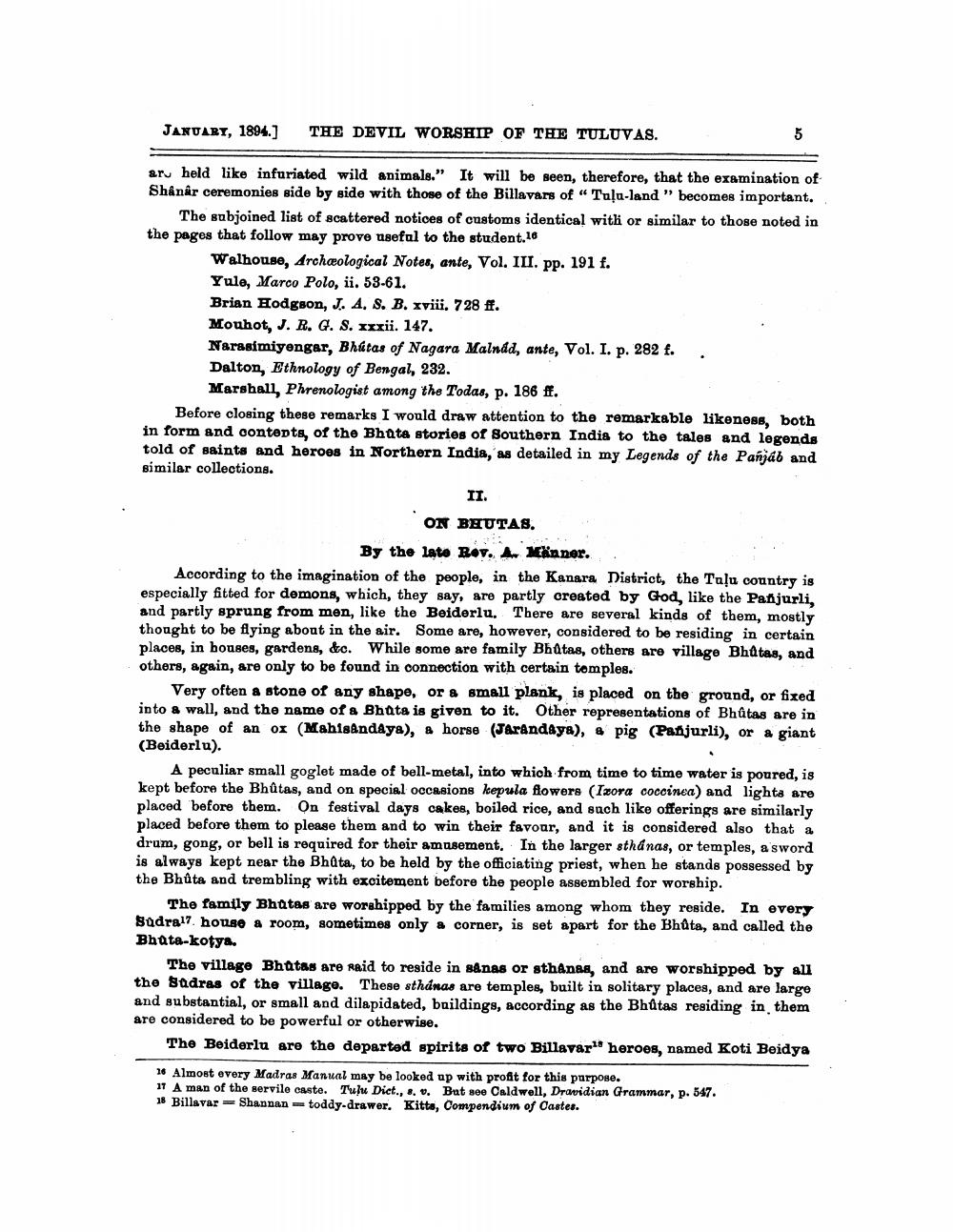Book Title: Indian Antiquary Vol 23 Author(s): Richard Carnac Temple Publisher: Swati Publications View full book textPage 9
________________ JANUART, 1894.] THE DEVIL WORSHIP OF THE TULUVAS. eru held like infuriated wild animals." It will be seen, therefore, that the examination of Shânár ceremonies side by side with those of the Billavars of “Tuļu-land" becomes important. The subjoined list of scattered notices of customs identical with or similar to those noted in the pages that follow may prove useful to the student.10 Walhouse, Archæological Notes, ante, Vol. III. pp. 191 f. Yule, Marco Polo, ii. 53-61. Brian Hodgson, J. A. S. B. xviii. 728 ff. Mouhot, J. R. G. S. xxxii. 147. Narasimiyengar, Bhútas of Nagara Malndd, ante, Vol. I. p. 282 f. . Dalton, Ethnology of Bengal, 232. Marshall, Phrenologist among the Todas, p. 186 ff. Before closing these remarks I would draw attention to the remarkable likeness, both in form and contents, of the Bhata stories of Southern India to the tales and legends told of saints and horoos in Northern India, as detailed in my Legends of the Panjab and similar collections. ON BHUTAS. By the lato Bor. A. Männer. According to the imagination of the people, in the Kanara District, the Tuļu country is especially fitted for demons, which, they say, are partly created by God, like the Panjurli, and partly sprung from men, like the Beiderlu. There are several kinds of them, mostly thought to be flying about in the air. Some are, however, considered to be residing in certain places, in houses, gardens, &c. While some are family Bhatas, others are village Bhatas, and others, again, are only to be found in connection with certain tomples. Very often a stone of any shape, or a small plank, is placed on the ground, or fixed into a wall, and the name of a Bhata is given to it. Other representations of Bhůtas are in the shape of an ox (Mahisandaya), a horse (Jarandaya), & pig (Panjurli), or a giant (Beiderlu). A peculiar small goglet made of bell-metal, into which from time to time water is poured, is kept before the Bhûtas, and on special occasions kepula flowers (Ixora coccinea) and lights are placed before them. On festival days cakes, boiled rice, and such like offerings are similarly placed before them to please them and to win their favoar, and it is considered also that a drum, gong, or bell is required for their amusement. In the larger sthanas, or temples, a sword is always kept near the BhQta, to be held by the officiating priest, when he stands possessed by the Bhûts and trembling with excitement before the people assembled for worship. The family Bhutas are worshipped by the families among whom they reside. In every Sudra17. house a room, sometimes only a corner, is set apart for the Bhúta, and called the Bhata-kotya. The village Bhatas are paid to reside in s&nas or sthanas, and are worshipped by all the Sadras of the village. These sthanas are temples, built in solitary places, and are large and substantial, or small and dilapidated, buildings, according as the Bhůtas residing in them are considered to be powerful or otherwise. The Beiderlu are the departed spirits of two Billavar" heroes, named Koti Beidya 26 Almost every Madras Manual may be looked up with profit for this purpose. 11 A man of the servile casto. Tulu Dict., ..0. But see Caldwell, Dravidian Grammar, p. 547. 16 Billavar-Shannan toddy-drawer. Kitta, Compendium of Castes.Page Navigation
1 ... 7 8 9 10 11 12 13 14 15 16 17 18 19 20 21 22 23 24 25 26 27 28 29 30 31 32 33 34 35 36 37 38 39 40 41 42 43 44 45 46 47 48 49 50 51 52 53 54 55 56 57 58 59 60 61 62 63 64 65 66 67 68 69 70 71 72 73 74 75 76 77 78 79 80 81 82 83 84 85 86 87 88 89 90 91 92 ... 412
